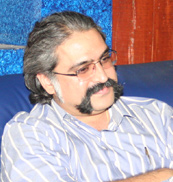 “Unlike today where a new rookie wants to do particles and dynamics on day one, we grabbed every opportunity to work and learn every aspect of the business.”
“Unlike today where a new rookie wants to do particles and dynamics on day one, we grabbed every opportunity to work and learn every aspect of the business.”
When and how did you get into animation
I started in my career in animation in 1989 at Computer Graphiti (Bombay) Pvt. Ltd. I kind of just walked in from my hometown into Prahlad Kakkar’s office and said I want a break in computer graphics and animation and he put me on to Ashish at Computer Graphiti and that’s how it all started.
It was a mighty lucky break to be able to learn the craft from such talented people and I understood the significance of this, respected the opportunity and went about making the most of it. All my learning has been on the job and what I am today in this medium is largely due to the interest and commitment of people in teaching and tutoring me in the initial years. I think I was a good student – ‘adarsh balak’ is what they called me!
Incidentally I have done my time – from cleaning the office to being the chai wala, to being the digital janitor (data backup and restore boy) to render manager doing the unwanted night shifts to production flunkie etc etc. Unlike today where a new rookie wants to do particles and dynamics on day1, we grabbed every opportunity to work and learn every aspect of the business. There was and still is no shame or stature issue for undertaking any job/role. The golden rule is ‘when in office – leave your ego outside’.
When was TASI formed and what were the initial years like?
TASI was formed in 2001. The initial years were a struggle as we were met with a lot of skepticism about our motives and selfless commitment towards the industry. A lot of people stayed away as they thought that this was another attempt at self glorification thru collective hype. But I’m proud that today our organisation is above individuals and personal agendas. We have maintained a successful neutral stance and continue to be an organisation promoting artists and are perceived to be devoid of affiliations and hidden agendas.
Current status of TASI as in whats happening at TASI at the moment.
Elections to the new managing committee are around the corner. We recently hosted a session by Famous House of Animation. Before that we hosted a session by Dhimant Vyas who is the first Indian animator invited by Aardman Studios to work at their facility. Aardman is the creator of the award winning Wallace & Gromit series.
We are also in talks with a lot of people from all over India and overseas and you will shortly hear very interesting announcements from us plus a number of speakers have been lined up for sessions on a variety of subjects and as soon as we get confirmations on dates from them, we will organize their presentations.
Your views on the industry
Positively Good. A lot of delightful stuff is happening all over the country and the quality of animation, the end product in general is fantastic. We just need to be careful of hype.
Additional comments?
TASI will promote animators and their animation -irrespective. We don’t care about the higher motives or who did what and what not. This is a platform for the artists and they are free to send in material which we will help to promote. We would love to see a lot more independent work coming in but that is more to do with personal desires of encouraging indigenous content and less to do with our preferences. This is a platform and all are welcome to use it.
What are the problems that you see with Indian animation?
In my personal opinion it is organisation, finance, basic animation training, unity and foresight that come to mind immediately. We tend to sell ourselves short. I’ve seen artists here look at western productions and go cockeyed and the general tendency is to attribute it to the hardware and resources. We have access to the same hardware, software and comparable people in most large studios and in fact in some cases it’s even better. I feel patience among the emerging generation is the key missing element. Instant gratification is the name of the game. We don’t want to learn about production, film making, editing, story telling, sound design and a host of other aspects that go into becoming a good animator. Animation to most artists today is a compartmentalized exercise. This development among the emerging talent is not good for us as an industry.
Whats the positives that you see emerging?
Overseas interest in India, a large part of this is the result of our own efforts. Though there are some bad apples, but honestly, where don’t you find them?
Your future plans.
These are interesting times. So wait and watch.

